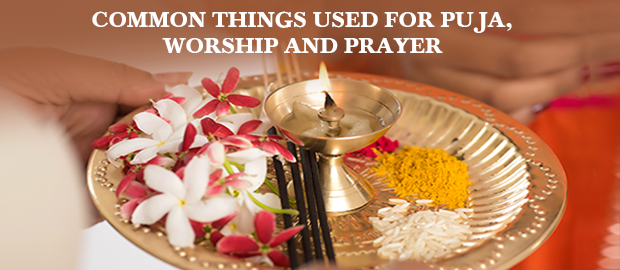Common Things Used for Puja, Worship and Prayer
For the spiritually inclined, worship and prayer are an indispensable part of their lives. It is a powerful means of glorifying the deity or the Guru and expressing gratitude for all the blessings we have received. When puja is performed with sincerity and devotion, it strengthens the connection with your inner Self. Puja fortifies and deepens the Guru-disciple relationship.
In the Indian tradition, puja, worship or prayer typically includes meditation, repetitions of mantras, recitation of sacred texts, waving of arati lamps, havans and yajnas (sacred fire rituals). For these practices, various puja items and sacred accessories are used. These items help adorn, enliven, purify and uplift the energies of the place of worship.
Traditionally, puja is offered once in the morning at sunrise and once in the evening at sunset. The puja altar is cleaned, and flowers are placed along with a lit lamp and incense stick.
- Statues: The object of our worship is given form either through a murti (statue) of our chosen deity or photographs of our Gurus. The murti or photo is the heart and soul of the puja. Contemplating and meditating on the form of our chosen deity or Guru helps us to imbibe the qualities and virtues that they embody.
- Puja cloths: These beautiful pieces of cloth are used to adorn the puja space. The murtis of deities and photos of the Guru are placed on puja asanas. They are also used to cover or wrap sacred texts and prayer books.
- Flowers: Offering puja feels incomplete without flowers. Mother Nature renews herself every day, and flowers are a symbol of her bounteous blessings. Flowers are vibrant, fragrant symbols of the power of renewal and rejuvenation. When we offer flowers during puja, it represents our choice to refresh our commitment to our spiritual practices and sadhana.
- Lamp or candle: The flame of the candle or lamp represents the light of the Self. It is a physical and visual reminder that the effulgent and luminous light of the Self resides within us. Lighting a lamp or candles for puja or meditation helps create a calming atmosphere that soothes the mind. The bright flame is often used as the focal point during meditation to increase focus and limit distractions.
- Incense and dhoop: Burning incense infuses the air with a divine fragrance that immediately anchors us in the present moment. A sense of calm and serenity pervades the atmosphere, creating an environment conducive to meditation and prayer. Dhoop is a mixture of twenty sacred herbs that possess medicinal and cleansing properties. Using dhoop cleanses and purifies your space, while the lingering fragrance of the dhoop infuses positivity and a sense of well-being.
- Kumkum: Another significant item used for daily worship, kumkum is a symbol of auspiciousness and good fortune. It is offered as a sign of gratitude and used to sanctify and decorate statues of deities or photos of spiritual masters. After praying or completing the puja, kumkum is applied to the middle of the forehead as a mark of honouring the divinity within. The middle of the forehead corresponds to the sixth chakra (ajna chakra), known as the third eye, associated with inner wisdom and intuition.
- Camphor: Camphor is made from the purest resins of pine trees. It has a long-lasting fragrance that purifies the entire house. Used particularly during the waving of arati lamps, camphor cleanses negative energy and fills the space with positive vibrations. It is also believed to have healing properties that help alleviate stress and anxiety.
- Japa Mālā: This is another significant item commonly used for prayer, puja and meditation. In many spiritual traditions, a japa mālā is used for mantra chanting or to enhance focus while meditating. Depending on the number of beads they have, japa mālās are available in the form of bracelets or necklaces. The beads of a mālā are made from seeds of sacred plants such as lotus, tulsi or rudraksha. They are also made of semi-precious stones or crystals that have vibrational healing properties.
The act of puja or worshipping the Lord/Guru is a precious and sacred time. A time when we go within and connect to higher wisdom and power that sustains this entire universe. When you use these items during your daily practice of puja, imagine that you are building a bridge between you and the Divine. Their purpose is to help you sustain and amplify this mystical connection.

